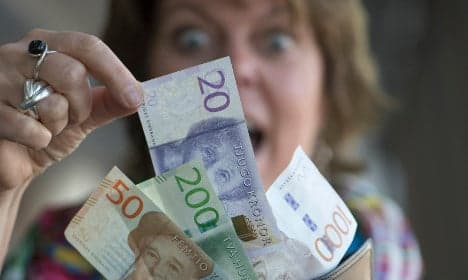Sweden cashes in on new kronor banknotes

Sweden's new banknotes have got off to a flying start. A month after their release, more than 1.3 billion kronor ($150 million) worth of new money is in circulation – in a country that increasingly prefers to pay by card.
Sweden introduced brand new 200 kronor notes and launched updated versions of 20, 50, and 1,000 kronor cash as part of its biggest currency changeover in decades at the start of October.
The head of the country's central bank (the Riksbank) Stefan Ingves made the first purchase himself, using one of the new notes, picking up a children's book about Pippi Longstocking by famous Swedish author Astrid Lindgren.
Other new bills worth 1.349 million kronor were distributed in the first month, Christina Wejshammar, head of the Riksbank's department for cash supply, told Swedish news agency TT late on Tuesday.
“It's gone very well. We haven't hit any bumps along the road,” she added.
The 20 and 50 kronor notes are the most common ones so far, she said. But plenty of Swedes have been hoping to get their hands on the 200 kronor bill, a completely new bank note value in the Nordic country, which is only being issued by a select number of cash machines so far.
“The 200 kronor bill is probably going to become more common after the turn of the year when they'll be around in all cash machines. That's almost the only way to get hold of one of them,” said Wejshammar.
IN PICTURES: Sweden's new bank notes
New coins will also be arriving in Sweden next year, including a brand new two kronor. A fresh set of one and five kronor coins will also be introduced, while the ten kronor coin will be the only currency that doesn't get a makeover.
Today's 20, 50, and 1,000 notes will no longer be valid after June 30th 2016. The current 100 and 500 will be invalid after June 30th, 2017, together with the 1, 2, and 5 kronor coins.
Swedes have become less dependent on cash in recent years and four out of five purchases in Sweden are made electronically or by debit card.
Today around two percent of Sweden's total GDP is made up by cash. The corresponding figure in the year 1990 was almost 10 percent.
Comments
See Also
Sweden introduced brand new 200 kronor notes and launched updated versions of 20, 50, and 1,000 kronor cash as part of its biggest currency changeover in decades at the start of October.
The head of the country's central bank (the Riksbank) Stefan Ingves made the first purchase himself, using one of the new notes, picking up a children's book about Pippi Longstocking by famous Swedish author Astrid Lindgren.
Other new bills worth 1.349 million kronor were distributed in the first month, Christina Wejshammar, head of the Riksbank's department for cash supply, told Swedish news agency TT late on Tuesday.
“It's gone very well. We haven't hit any bumps along the road,” she added.
The 20 and 50 kronor notes are the most common ones so far, she said. But plenty of Swedes have been hoping to get their hands on the 200 kronor bill, a completely new bank note value in the Nordic country, which is only being issued by a select number of cash machines so far.
“The 200 kronor bill is probably going to become more common after the turn of the year when they'll be around in all cash machines. That's almost the only way to get hold of one of them,” said Wejshammar.
IN PICTURES: Sweden's new bank notes
New coins will also be arriving in Sweden next year, including a brand new two kronor. A fresh set of one and five kronor coins will also be introduced, while the ten kronor coin will be the only currency that doesn't get a makeover.
Today's 20, 50, and 1,000 notes will no longer be valid after June 30th 2016. The current 100 and 500 will be invalid after June 30th, 2017, together with the 1, 2, and 5 kronor coins.
Swedes have become less dependent on cash in recent years and four out of five purchases in Sweden are made electronically or by debit card.
Today around two percent of Sweden's total GDP is made up by cash. The corresponding figure in the year 1990 was almost 10 percent.
Join the conversation in our comments section below. Share your own views and experience and if you have a question or suggestion for our journalists then email us at [email protected].
Please keep comments civil, constructive and on topic – and make sure to read our terms of use before getting involved.
Please log in here to leave a comment.